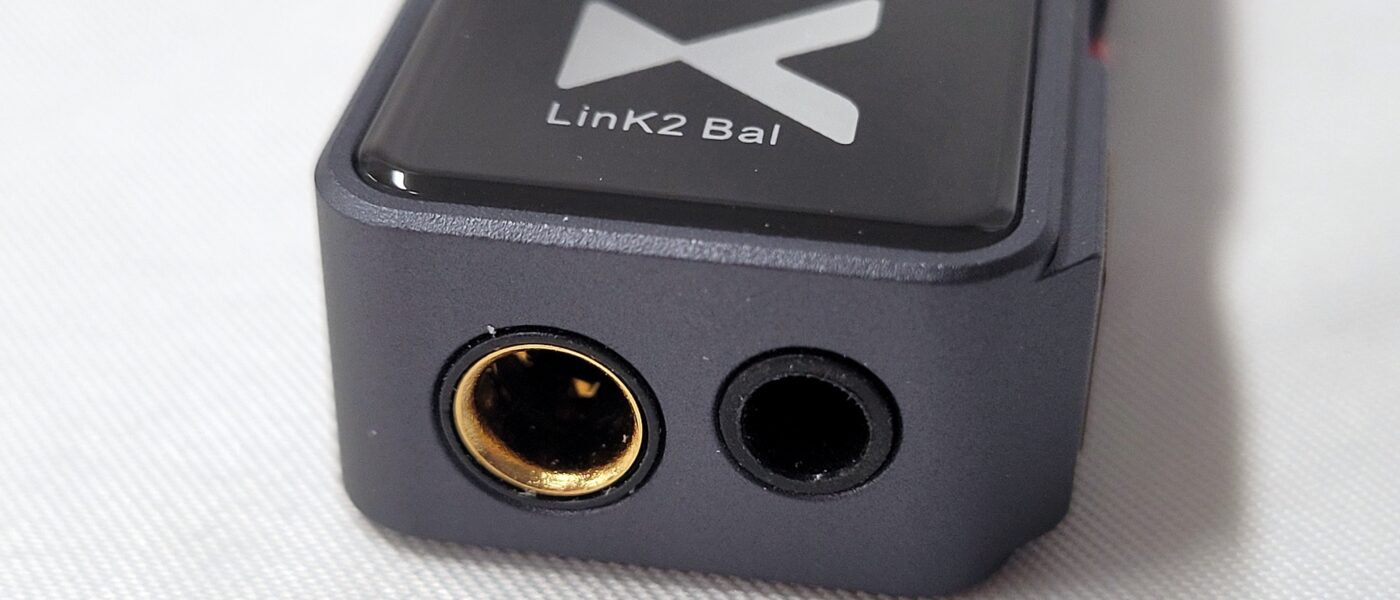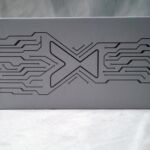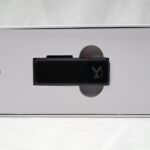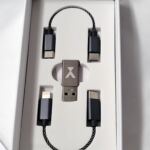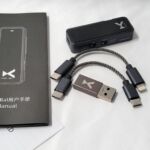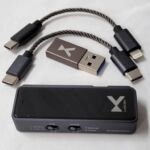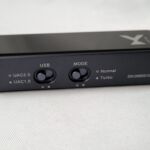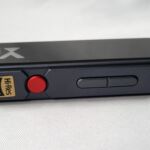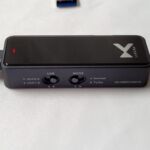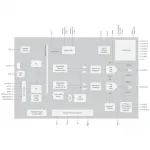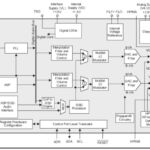Xduoo Link 2 Balanced
disclaimer: The Link 2 Balanced was sent for purposes of review by Xduoo. I have no financial interest in Xduoo, nor have I received any remuneration for this review. If you have an interest in learning more about the Xlink 2 or other Xduoo products check out their website.
Packaging:
Packaging is similar to the previous generations of Link dongle as is the kit. The box has an outer slipcover and an inner lift-top box. The slipcover is blue with Link 2 in blue with orange accents and Bal in Blue with an orange background. The slipcover does not have all the specs on it but does have a hi-res audio logo on front and links to the website listed on the rear. The inside box has the Xduoo circuit logo in silver/gray on a white background on the cover. Lifting the box top reveals instructions on top, the dongle in a foam surround in the middle layer, and then the cables (USB-C to USB-C, and USB-C to Lightning), USB-A to USB-C Adapter, and magic sticker for attaching the link2 to a source device. Some form of carrying case would be a nice addition, but none is provided. At the price and especially considering apple support, this is hardly a deal breaker though.
Build:
The unit is quite small at nearly the same size as a pack of Wrigley’s gum. Exact size is 64 x 24 x 13mm. The faces are black glass with a single piece rolled gray aluminum shell around the sides. the nose of the unit has a 3.5mm port and a 4.4mm port while the tail has a USB type-C port. The right side of the body have two switches the first for UAC and the second for gain (listed as normal and turbo. On the left hand side of the unit is the play/pause button recessed to avoid accidental taps, and a rocker switch for volume up and down. The Play /Pause button is bright red completing the typical Grey/Red color scheme of Xduoo products. The unit feels very solid in the hand and controls all operate very positively with no worries of accidentally switching any of them. The front face has a hidden LED indicator lamp near the USB connection. The LED displays either red, blue, or green depending on the type and bit-rate of the input.
Internals:
The Link 2 Balanced is powered by a SOC or system on a chip design using two Cirrus Logic CS43131 chips. This is a marked difference from the Link 2 which used an ESS9118EC soc. The up-side to these SOC designs is they handle USB input, Digital to analog conversion, filtering , and amplification duties all in a very small amount of space and all while using less power than most systems that use discrete components for each function. There is also a cost savings for manufacturers and it simplifies the supply chain as well. The down-side is often that they limit output power considerably so Xduoo has used the 43131s for input, dac, and filtering functions, but has seperated the amplifier circuits out and used a discrete design for improved output power. The DAC itself can be thought of a a 43198 family member and supports 32/384 PCM and DSD256. There is not a provision for MQA. Amplification is handled by addition chips but is not documented other than to list the TI LM27762 as providing power for the output stage. Output power is listed as 125mW at 32Ω in single ended and 270mW with a 32Ω load when used balanced. I would note that some of the adverting material falsely lists these values as watts instead of milliwatts and while that would indeed power most headphones more than adequately, the drain on your source device would likely be instantaneous and the heat generated enough to weld with. For more information on the CS43131, see the datasheet.
Another interesting feature of the Link 2 balanced is the ability to select UAC mode via the switch on the right side of the body. The Link 2 balanced supports UAC 1 or UAC 2 which allows the link to work with older hardware that may not have support for UAC2.0. Using USB Audio Class 1.0 will limit playback to 96kHz. USB Audio Class 2.0 supports audio at the full capabilities of the device so is preferred if supported by your host device. Some older PCs may struggle with UAC2.0 and require dropping to 1.0 but any device made in the last 4-5 years should fully suport UAC2.0.
Sound:
The Cirrus Logic chips are often overlooked in favor of the AKM or ESS series chips but are still quite capable and to many hit the sweet spot between the two other series. The implementation in the Xduoo Link 2 balanced hits a nice balanced between detail and smooth delivery with good note weight and just a hint of warmth to the sound. This helps tame poorly recorded tracks a bit while not detracting from better mastered material by becoming overly smooth.
Lows have good weight and sub-bass presence with no sign of being under-powered (when headphones are kept within reasonable limits). Sub-bass texture is about average with more detail available as it moves toward the mid-bass. Mid-bass has a slight warmth but good detail and texture and good slam when called for.
Lower-mids have good weight and lower vocals in particular show off with a nice realistic timbre in addition to the slight warmth. When combined the warmth, texture, and weight make for a very lush, vocal. Strings have good energy and guitar growl is as expected with enough sharpness to sound realistic but not quite ragged. Female vocals are a little thinner than lower voices but still have good timbre and cut through the mix well.
Treble is well detailed with a clean presentation and good extension. Air and sparkle are more a function of the headphone in use as these varied considerably throughout my testing depending on what was paired to the Xduoo.
Comparisons:
Xduoo Link 2 – $109 The balanced shares some features like physical controls with its sibling but differs in chipset, controls, and output power with the single ended output being slightly less at 125mW on the Balanced vs 150mW for the original Link 2 (both at 32Ω). The balanced output doubles that to 270mW with the same load and is a clear winner for those looking to power harder to drive headphones. Signatures are similar with slightly better linearity (no ESS Hump) and slightly richer tone to the Balanced when compared head on. If you don’t need balanced output, it would be tempting to save the $50 and go with the Link 2 as it does have a bit better battery life, but if you need that extra driving power the Balanced is the clear winner.
Cayin Ru6 – $249 Stepping up, what does an extra $100 spend get? The answer is a slightly larger box with a display screen, both support lightning and USB type-C so that’s a wash, and both are very solidly constructed. The two models have similar power with the the Ru6 having slightly more single ended output (138mW) and less balanced (213mW) than the Link2 Bal. File support is about the same as well as both support 384 PCM and 256 DSD. The signatures do differ as the Balanced if fuller and warmer while the Ru6 is more detailed and cleaner but a bit cooler as well.
DDHifi TC44b – $90 – What does stepping down $50 lose in the process? In a word, plenty. The Tc44b is smaller but not by enough to matter and it has a permanently attached cable that limits flexibility as you need a camera kit and USB A to C adapter to use it with lightning. It has no physical controls so those who prefer that to using phone controls will want to look at the Balanced, and the Tc44b has no single ended output with only 2.5mm and 4.4mm ports. The two do have the same CL 43131 so similar signatures, but the Balanced has more than twice the output power at 250mW vs 120mW for the TC44b. For low impedance earphones, the TC44b does a better job of preserving battery, for more demanding applications ,go with the balanced.
Hidizs S9 Pro – $119 Here we have a similar form factor, but without any physical controls and the S9 Pro uses a 2.5mm port vs the Balanced 4.4mm. The two models have nearly identical length with the width and height being smaller on the S9 Pro but sizes and weights are close enough it probably wont be noticed in pocket. They both support lightning to USB cables for use with Apple products, and both have glass faces with aluminum/magnesium/zinc (not sure) shells. The S9 Pro uses the 9038Q2m chip from ESS instead of the Cirrus Logic of the Balanced and has a slightly leaner signature with a touch more detail as a result. Output power of the S9 Pro falls slightly under the Xduoo at 200mW vs 270mW for balanced output and 100mW vs 125mW for single-ended. In most applications this won’t help differentiate the two so controls and signature are the decision points.
Conclusions:
I could speak to phones taking over the low-end DAP market, but most already know this and the reality is dongles are all the rage right now. Every maker has at least one and some makers have as many as four or five models vying for those consumer dollars. Form factors are all fairly similar as the whole goal is to make a product that can hang by the cable or jack from the phone without weight pulling it loose and without taking up so much space that it becomes clumsy to carry around. What separates one from the next is the feature set, some have physical controls, others have display screens, some offer bass boost, switchable gain, or microphone pass through.
The Xduoo Link series has done a good job playing the dongle game from the original Link, with its fixed cable to the Link 2 with removable cables and bass boost /3D options as well as physical controls, to the new Link 2 Balanced each generation has shown that Xduoo is learning from previous models and listening to what customers want.
With the Link 2 Balanced we have support for PCs, Apple devices, and Android devices with nothing else to buy (a plus for Apple users) in a solid package that should stand up well to daily use. The Link 2 Balanced combines good output power for a small dongle with physical controls for volume and play/pause as well as two levels of gain for matching the output to the headphone or in-ear paired with it. File support is good with 32/384 PCM and 256 DSD which covers most of the music available today and all the major streaming services, and signature is slightly warm and forgiving which makes it a good pairing for some of those same streaming services that don’t always have the best masters of various tracks.
The Xduoo Link 2 Balanced is not the cheapest balanced dongle on the market, but it isn’t anywhere near the top end of the cost spectrum either and when the features are taken into account, I would prefer to pay slightly more for the Xduoo Link 2 Balanced than many of its lower priced competitors as the things gained are worth that extra spend. I prefer 4.4mm to 2.5, I like the ability to use both balanced and single-ended headphones without switching devices, and the physical controls are a nice to have as well.
For the money, the Link 2 Balanced stands with the best available and is an easy recommendation.
-
Packaging - 7/107/10
-
Accessories - 8/108/10
-
Build Quality - 7.5/107.5/10
-
Sound Quality - 7.5/107.5/10
-
Output Power - 8/108/10
Summary
Pros – USB and Lightning options out of the box, Physical Controls for play/pause and volume, both 3.5 and 4.4mm
Cons – No MQA support (not a concern for some but a limiting factor for others) , does drain phone battery faster than lower powered models.

